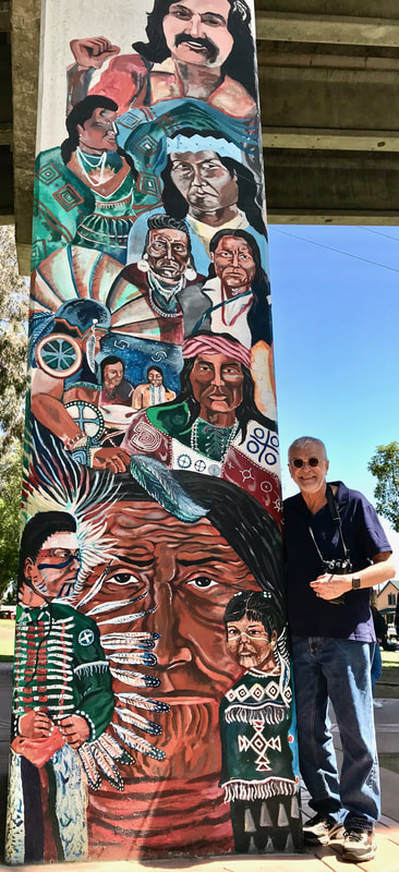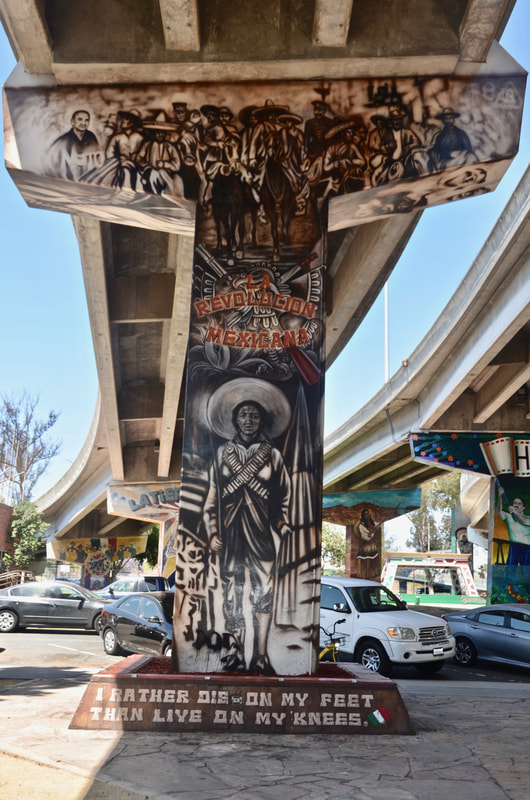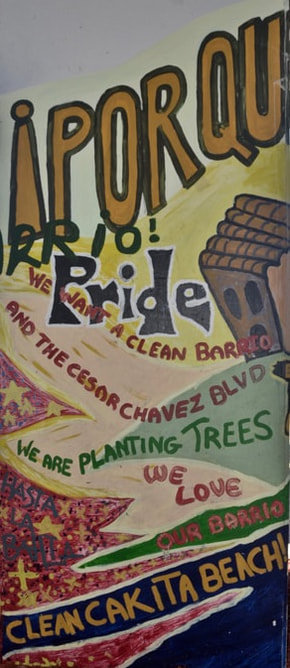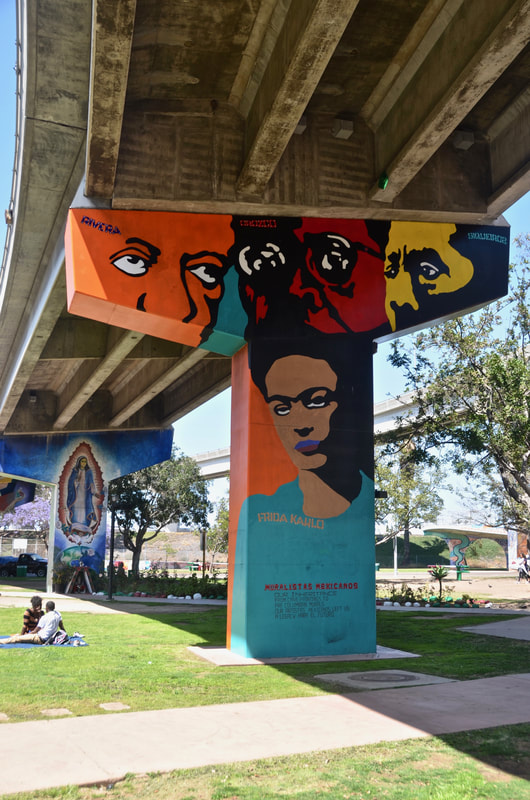91. Chicano Park: Mexican-American history painted on highway ramps
|
By Miguel Pérez
Their canvasses are not made of cloth and they often take the shape of a the letter T. They are gigantic murals painted on cement overpass support columns, but they are works of art just the same. And they tell the story of the Mexican-American experience! Some reflect the constant immigration struggles at the U.S.-Mexico border, some go back through the conflicts between the two countries and thus convey anti-American messages, and others recognize our Hispanic bonds and shared DNA with Native Americans. Others simply show that it was on the shoulders of Native Americans and Mexican Americans that much of San Diego was built. And yet others make it very clear that "La Lucha Continúa" - The Struggle Continues. The Great Hispanic American History Tour has arrived at Chicano Park, a 7.9-acre outdoor art gallery built under a huge intersection of San Diego highways. It's one of the country's largest collections of outdoor murals. But Chicano Park is much more than that! It's the heart and soul of the Mexican-American community in Logan Heights, or "Barrio Logan" - just south of downtown San Diego under the San Diego-Coronado bridge. Since it was established in 1970, Chicano Park has become the gathering place for all sorts of major events - from demonstrations to celebrations! Some historia: In the mid-1960’s when the state built a huge highway (I-5) that cut Barrio Logan in half, and displaced thousands of Mexican Americans who lived here, the state started to build a Highway Patrol station under the highway, between the huge concrete pillars where Chicano families had lived all their lives. But this was at the height of the Chicano Movement, a time when Mexican Americans were fighting to attain their rights. And so Chicano students and community activists organized a non-violent takeover. Dozens of men, women and children confronted a few workers with bulldozers, created human chains around them, and stopped the construction. But they didn’t stop there. They occupied the area for 12 days, while they planted flowers and trees and began to build their own park! As a result, the city agreed to acquire the land from the state, to create a community park in which Chicano culture could be expressed through art. It was a huge victory. But because the Chicano community had to fight for it, "Chicano Park - La Tierra Mia - Our Land" became a symbol of their right to self-determination. "The Park is where our history is enshrined in monumental murals," according to the park's website. "It is where we keep making history as we fight to preserve and defend a small piece of Aztlán known as Chicano Park in Barrio Logan, San Diego." The site also notes that, "By claiming Chicano Park, the descendants of the Aztecs the Chicano Mexicano people begin a project of historical reclamation. We have returned to Aztlán - our home." Yet, because they call the park "El Corazon the Aztlán," because they express a romantic, idealistic, and purely symbolic wish to return to the ancestral home of the Aztec peoples, there are some wacko, racist, anti-Mexican extremists who take it all very seriously, and use it as an excuse to attack Mexicans Americans. One of them devoted an entire Facebook page to opposing the park, and trying to make it seem as if the place where I saw art and history on display, where I saw families gathered and children playing, is somehow a center for leftist, anti-American activity. It's bull crap. This is purely a hatred page, devoted to attacking Mexican culture. I don't know why Facebook allows it, but it is part of what I found while researching this destination. In February, an alt-right group claiming that the park discriminates against non-Hispanics held a "Patriotic Picnic," which was nothing more than an anti-immigrant demonstration and provocation in the heart of the Mexican American community. When shouting "build that wall," they were confronted by a much larger crowd of area residents, and apparently, they lost the shouting matches and a couple of fistfights. The Great Hispanic American History Tour stopped at Chicano Park in the daytime, when taking photos of the murals was much easier. But in the evenings, the park's volunteer steering committee presents an impressive program of cultural events, especially Aztec indigenous dance groups. Check out their website at chicano-park.com When you come here, give yourself time to examine numerous astonishing murals - restored in 2012 - and to interpret the many messages they convey. I promise: You will not turn into a commie, and you will learn some Mexican-American history. Here you will find an impressive statue of Mexican Revolution hero Emiliano Zapata, and the murals that feature at least a couple of his famous quotes: "La tierra es de quien la trabaja" (The land belongs to its workers) and "Mejor morir de pie que vivir arrodillado" (I rather die on my feet than live on my knees). The park, its mural artists, and the community volunteers who keep it all vibrant have received much well-deserved recognition in the past 48 years. This amazing place has been recognized as a historic landmark by the city, the state and the nation. I'm glad I visited the heart of Aztlán. STUDENT RESPONSE:
“I am extremely proud to call myself Hispanic after reading this article. Fighting against tyranny and racism has always been part of Hispanic culture but to see examples of rebellion in art is especially refreshing. Seeing depictions of protests and oppression painted on otherwise ugly pieces of concrete fills me with both a sense of hope and appreciation. I am very glad to have found out about this piece of Hispanic Heritage and I am especially grateful to my Mexican brothers and sisters.” — Jannette Medina “What I found most fascinating yet annoying was that anti-Immigrant, anti-Mexican extremists really believe that Chicano park is anti-American. There are many things dedicated to the history of white, non-Hispanic, men in this country, from statues to museums. Why is it a problem if Chicano park is the symbolic land that Mexicans have to claim? Having a “patriotic picnic" and shouting "Build that wall" is disgusting, spiteful, and ignorant in my opinion.” — Amberly Castillo “The murals of Chicano park illustrate a sense of pride that Mexican Americans had to earn for themselves. So much heart and soul is prominent within these murals. The racism that still exists against Mexican-Americans is definitely heart-breaking. Like every other person of color, Mexican Americans want something that belongs to them. Why not let them enjoy it?” — Jasmine Gonzalez “I thought the pictures of the murals in Chicano Park were brilliant. Professor Perez shared quite a few and some of them took my breath away. The fact that these murals depict the history of Chicanos and the struggles they endured is humbling. It's so fitting that La Lucha Continúa/The Struggle Continues is a common theme there as the Mexican –Americans fought for their rights and then fought for the land they had lived on under the new highway. I think it’s amazing that this park has been there for 50 years and it is a true testament to the spirit of the Mexican-American people.” — Carolyn Lluesma “I am not artistic in any sense and I always have some difficulties understanding art but with the pictures that the Professor provided as well as the descriptions are written in the chapter, the artwork on the murals could not be any clearer. The messages that these murals tried to invoke really make sense in the grand scheme of the Chicano movement and I think it is important for people not only to see these murals but to understand why exactly they paint the things they do.” — Jennifer Madrid “Chicano Park is something Mexican Americans and Hispanics deserve because it is their right as any other culture, to express their experience and tell their story, not only that but, Chicanos fought to preserve this piece of land they call home. Es como tener un pedacito de su tierra con ellos. It is disappointing to read that there are people who take the time to spread hatred, the world is full of it, there no need for more.” — Reny Marinez Above are the opinions of students in my "Roots of Hispanic Heritage" course at Lehman College, CUNY. |
To enlarge any photo, click on them!
|
|
Next, The Great Hispanic American History Tour will stop at another park in San Diego, a totally different and yet equally beautiful park. Amazingly, we'll also walk into a totally different and equally painful controversy.
We'll go from Aztlán to Europe in just a very short drive! |



















































